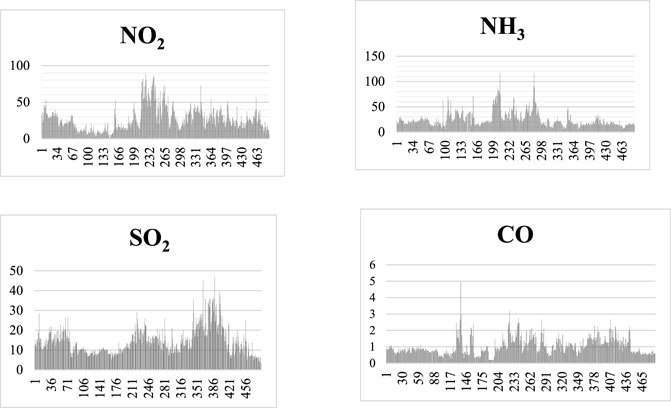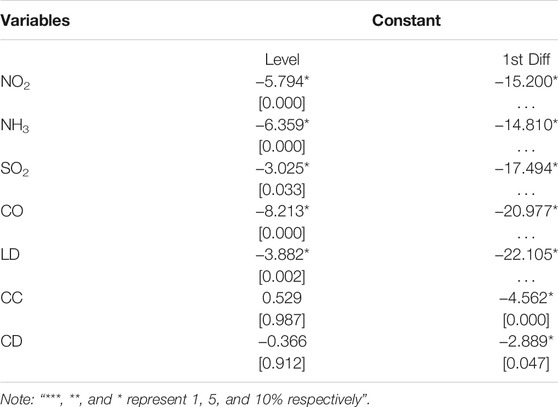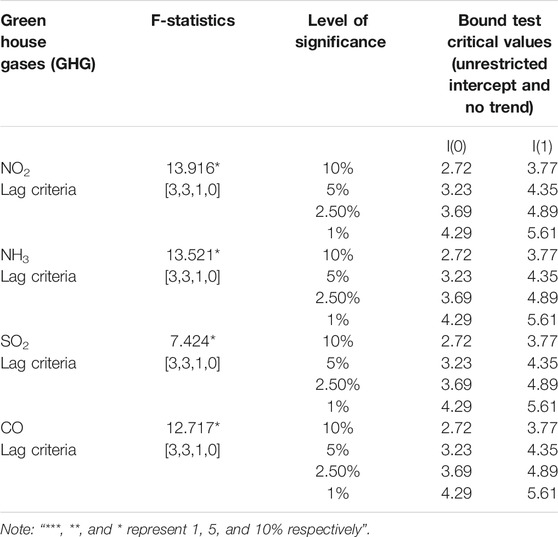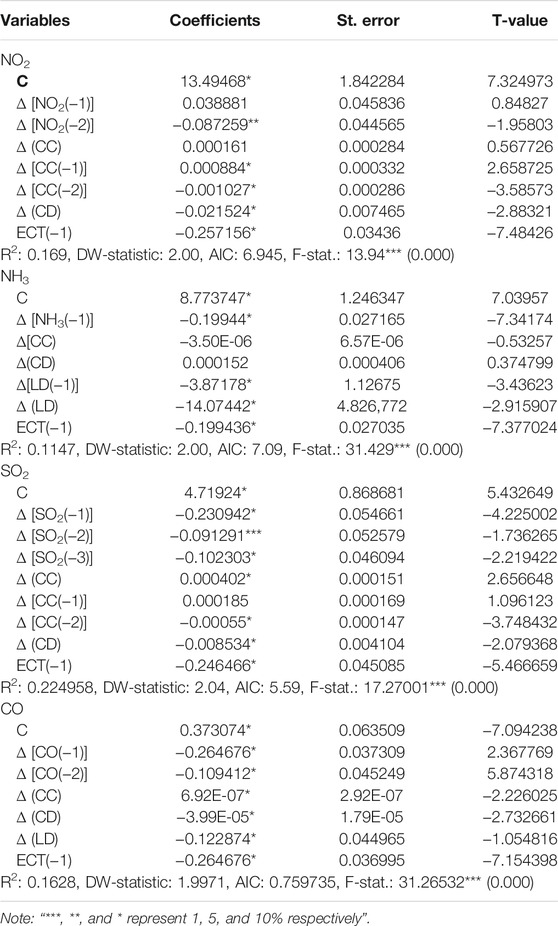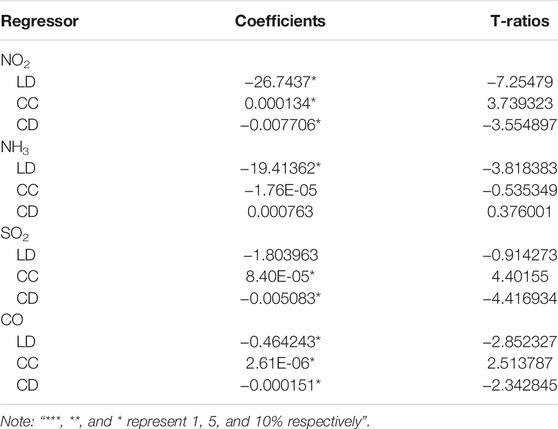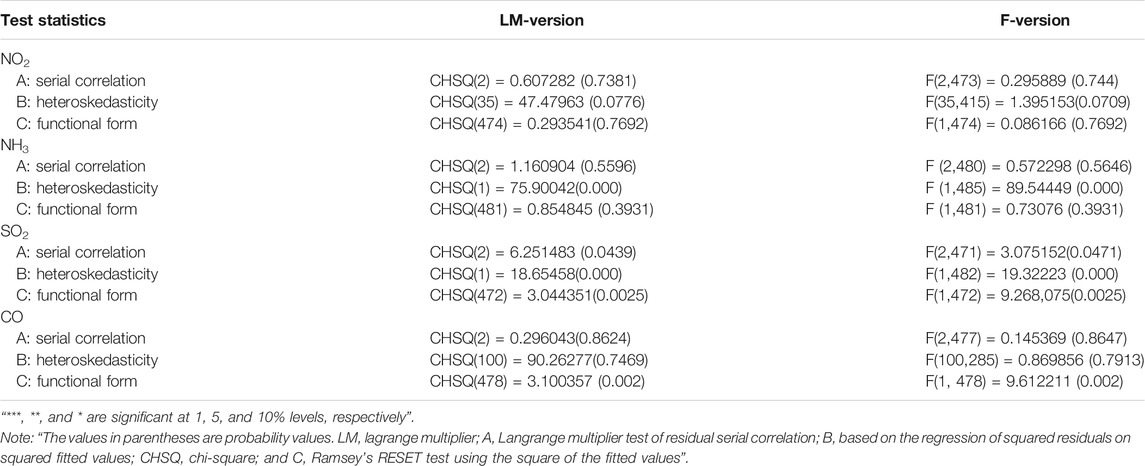- 1School of Business, Hunan University of Humanities, Science and Technology, Loudi, China
- 2School of Economics and Management, Shijiazhuang Tiedao University, Shijiazhuang, China
- 3College of International Students, Wuxi University, Wuxi, China
- 4Department of Management, Faculty of Management in Production and Transportation, Politehnica University of Timisoara, Timisoara, Romania
- 5Department of Zoology, College of Science, King Saud University, Riyadh, Saudi Arabia
The COVID-19 pandemic has compelled countries worldwide to enforce stringent measures to maintain social distancing, by locking down populations and restricting all kinds of transport. Besides their impact on the virus, these dramatic changes may also have positively contributed to a sustainable environment. The study aims to measure the effect of COVID-19 on environmental sustainability by employing the autoregressive distributed lag (ARDL) model. The study is based on the daily data of COVID-19 confirmed cases; confirmed deaths; manually generated lockdown data by the indexing method; and NO2, NH3, SO2, and CO levels from March 3, 2020, to July 27, 2021. This research study investigates the long- and short-term relationship between COVID-19 and the aforementioned greenhouse gases. The findings suggest conclusively that NO2, SO2, and CO declined during the COVID-19 period in India because these gases are anthropologically emitted by transport, industries, and fossil fuel burning. On the other hand, the evolving NH3 is not related to COVID-19 confirmed cases and deaths but is impacted by lockdown because ammonia emission is directly related to agricultural activities. Therefore, a decline in pollutants such as greenhouse gases during the COVID-19 period until July 2021 was observed. This means the prioritized control of human activities can be helpful to enhance the quality of the environment.
Introduction
Over the years, phenomenal advances in epidemiology have predicted the emergence of wide epidemics in the human population. The globalization of human communities has facilitated the transmission of infectious diseases, leading to a higher risk of global outbreaks. The distressing effects of the great pandemics of the past have potentially influenced human development, while the historical evolution of epidemics has drastically modified the living standards, affecting worldwide economies.
Similarly, the recent coronavirus pandemic (COVID-19) has strongly affected the global economy. The shift in the rhythm of people’s livelihoods has transformed the world’s socio-economic structure, developing an inextricable relationship between human development and epidemics. In December 2019, the massive disruptions caused by COVID-19 imposed a new strain in many countries causing them to experience an extensive turmoil. The emergence of the causative virus was first reported from Wuhan, China (Huang et al., 2021). Its clinical manifestation has caused an extensive turbulence worldwide. The wide spread of this deadly disease has seen a high fatality rate, with vulnerable population particularly experiencing its severity. The latest statistics (August 1, 2021) report 210 million confirmed cases, with more than 4 million people dying because of COVID-19 (Ritchie et al., 2020). However, besides the unprecedented consequences of the pandemic, research has also revealed that the impact of COVID-19 has improved the environmental conditions, thereby limiting the greenhouse emissions (Kumar and Kumar, 2020; Mandal et al., 2020; Mishra and Kumar, 2021).
Air is an essential element needed for human survival. It plays a fundamental role in sustaining a healthy environment, thereby providing a safe and clean place to live. Improved air quality enhances individual well-being, making humans enjoy substantial health benefits.
In contrast, the historical reputations of air pollutants correctly make environmental containments the chief agent leading to the great tragedies of human civilization (Vulichi et al., 2021). The greenhouse emissions are crucial determinants of atmospheric quality. Environmental substances such as toxic gases produce a high concentration effect, thereby reducing the air quality. The greenhouse gases (GHSs) (i.e., CO2, NO, NH4, and SO3) result in environmental degradation (Manisalidis et al., 2020). Research shows that among these GHGs, CO2, SO2, and NO2 are the most harmful environmental contaminants affecting the global climate (Conibear et al., 2018). The emission of these gases deteriorates the air quality, resulting in environmental depletion (Gautam and Hens, 2020).
Subsequently, due to the increasing greenhouse emission, environmental unsustainability has become a global concern that hinders long-term social benefits. Unsustainable resources cause adverse effects such as atmospheric deterioration, air pollution, and global warming. The tremendous increase in pollution due to anthropogenic activities has made environmental sustainability the prime concern for meteorologists. Therefore, to maintain sustainable atmospheric conditions, unwanted greenhouse emissions should be restricted. Environmental sustainability should be ensured, mitigating the negative consequences of climate changes and thus achieving a clean atmosphere.
While the pandemic has undoubtedly had an adverse overall impact on human health, significant developments have been witnessed regarding the health of natural assets such as land, water, and air. It has been found that lockdown measures during COVID-19 reduced pollution levels, including air pollution, a crucial determinant of environmental quality during the COVID-19 period. According to a recent study, the decrease in human activities in China during the lockdown restrictions resulted in a significant decline in air containment (Wang et al., 2020). Furthermore, other findings illustrate that the global lockdown conditions remarkably reduced the atmospheric concentration, thereby positively modifying the air quality (Kumar et al., 2021; Sharma et al., 2020). This suggests that the precautionary policies during the lockdown period relieved the environment from some of the burden of human activities. Hence, the health-damaging impact of COVID-19 during the lockdown restriction significantly reduced the pollution level across the globe.
COVID-19 has disturbed the globalized economy, thereby throwing many countries into deep recessions. An immense increase in the death rate has had negative consequences for countries. To prevent the rapid transmission of the virus, governments enforced severe lockdown conditions worldwide. In the case of India, lockdown implications halted the nation’s economy while the number of confirmed cases grew. As of August 1, 2021, the data record 31.70 million confirmed cases, causing 424,773 to lose their lives. This vulnerable situation in India provoked the government to implement strict lockdown measures. Indeed, to manage the outbreak during this global emergency, a public curfew was officially announced on March 24, 2020, whereby Indian citizens were encouraged to practice social distancing. Socio-economic activities were also suspended (MHA, 2020). All industrial and commercial establishments remained closed. This abrupt lifestyle changes in India forced people to follow lockdown guidance, leaving their homes only as the final resort for their survival.
However, the pandemic and the steps taken to mitigate it reduced air pollution across the Indian Territory. A significant reduction in air containments reveals a decrease of poisonous substances in most of the cities of India (i.e., New Delhi, Bangalore, and Mumbai). Given this statement, a notable decline in the greenhouse concentration (i.e., NO2) was recorded across the Indian region (e.g., New Delhi, Ahmedabad, Bangalore, and Nagpur) (Vadrevu et al., 2020). Likewise, the recent finding demonstrates that during the lockdown situation in India, the decline in the concentration level of greenhouse emissions (e.g., NO2, CO2, and O3) lead to an improvement in the national environment (Kumar ad Gupta, 2020; Sharma et al., 2020; Kumar et al., 2021). Perhaps, aside from curtailing COVID-19, the findings provide a clear justification for the Indian government to accelerate efforts to improve the national air quality (McDonald et al., 2020).
Over various geographical regions of India during COVID-19, a healthy correlation was witnessed between the pollution intensity and COVID-19 severity. The decline in socio-economic activities improved the pollution status, reducing the exhausting environmental emissions (Kumar and Kumar, 2020; Mishra and Kumar, 2021; Singh et al., 2020). As such, the viral outburst of COVID-19 has drastically enhanced air quality, contributing to the recovery of the global environment, albeit perhaps temporarily.
Altogether, the results show that the COVID-19 implications have enhanced the environment by widely improving the air quality. This temporary improvement in atmospheric conditions has demonstrated the importance of reducing greenhouse emissions, thereby gaining environmental sustainability. Primarily, therefore, this study aims to determine the air pollution level during the COVID-19 lockdown period. It investigates the fundamental relationship between the pollution status and COVID-19 susceptibility. As such, this study has great significance in the context of India during the lockdown period.
The reduction in air substances and improvement in public health conditions reflect the truth regarding the atmospheric quality. The deadly COVID-19 pandemic provides a broad scope to the meteorologists and policymakers studying and planning for the rejuvenation of environmental health. This study aims to provide a scientific research that articulates pollution parameters to achieve air quality standards. Perhaps, the sustainable environmental management unintentionally implemented during the COVID-19 escalation gives reason to express the optimism regarding the recovery of global meteorological conditions. However, the question remains as to whether nations will be able to maintain the same kind of pollution reduction in the future. This research is conducted to find the solution to this question. Overall, this study suggests that countries can control greenhouse emissions, thereby achieving long-term environmental sustainability.
Materials and Methods
Data Description
This research aims to analyze the GHG emission data during the COVID-19 pandemic, in the period from March 3, 2020, to July 27, 2021. The fundamental reason behind the data selection period is that the first COVID-19 confirmed case in Delhi was recorded on March 3, 2020, and all data available at time of writing were included. The GHGs are considered as dependent variables, i.e., the nitrogen dioxide (NO2), ammonia (NH3), sulfur dioxide (SO2), and carbon monoxide (CO) measured in µg/m3, which shows the micrograms of gaseous pollutant per cubic meter of ambient air in India. The daily data series of GHGs are presented in Figure 1. The COVID-19 factors are used as the independent factors i.e., Lockdown (LD), Confirmed COVID-19 Cases (CC), and Confirmed COVID-19 Deaths (CD). The daily data series of GHGs are obtained from the Central Control Room for Air Quality Management—All India, and the COVID-19 data are obtained from the World Health Organization (WHO). The lockdown data are generated based on restrictions, with the proxies generated as 1 representing restriction and 0 showing no restraint in the specified areas.
Research Methodology
This research specifies the four log–log models with NO2, NH3, SO2, and CO with COVID-19. The simplest form of models is presented below:
The log–log form of models:
Nitrogen dioxide (NO2), ammonia (NH3), sulfur dioxide (SO2), and carbon monoxide (CO) are considered as dependent variables. The measurement scale of these selected greenhouse gases is micrograms of gaseous pollutant per cubic meter of ambient air. The COVID-19 parameters for structuring the models are lockdown, and confirmed cases and confirmed deaths of COVID-19. The last term of the equation
After designing the fundamental research structure, first, the stationarity of time series data is checked for the accuracy of different results. Then, the unit-root presence is confirmed with the nonstationarity of the data series. Finally, the basic equation of the Augmented Dickey–Fuller test is given as follows:
In the above equation,
Autoregressive Distributed Lag Model
The long- and short-run relationship can be checked by implementing the ARDL model’s cointegration approach on the selected data series. The ARDL model is the best model when the integration orders are a mixture of level I(0) and the first difference I(1) (Naseem et al., 2020; Mohsin et al., 2021). ARDL instantaneously acquires the dynamic, short- and long-run coefficients. Additionally, the OLS method is employed to check the cointegration relationship of NO2, NH3, SO2, and CO with COVID-19. The conditional error-correction model is given as follows:
In the above equations, cointegration among the dependent and independent variables is checked individually, such as NO2 (
Short-run ARDL model:
Long-run ARDL model:
The main models of short run and long run are presented above. The ECT term of the short-run model is to measure the speed of adjustment from the short to the long run. The sign of
Empirical Results
Table 1 contains the summary of descriptive results of the data series. The mean values are NO2 (27.489), NH3 (25.698), SO2 (14.599), and CO (1.040), confirmed COVID cases (524379), and confirmed deaths (27.489). The maximum range and minimum range of the data series are highly differentiated against each other, leading to instability. The content of the dependent variables is from 0.200 to 116.150, while the range of the independent variables is highly unpredictable and fluctuates between 0.630 and 1436207. Due to the unstructured data series with increasing trend, especially in COVID-19 cases and deaths, the standard deviation lies between 0.547 and 482,055. The confirmed cases of COVID-19 have shown a highly deviated series in the selected set of variables. The skewness confirms the positive skewness in all variables. The value of kurtosis is more than 3 in all series except the confirmed cases of COVID-19. The confirmed cases of COVID-19 show the normal distribution, and the remaining series are all leptokurtic. The range of Jarque–Bera is 54.665–1123.102, which is used to check the goodness-of-fit test.
The ADF results are presented in Table 2, which is employed to check the stationarity of the data series. The alternative hypothesis of ADF is checked on the stationary method, and the results indicate that some variables are stationary at the level and some at first difference. This mixture of results confirms the feasible ground to run the ARDL method (Sulaiman and Abdul-Rahim, 2018; Mishra and Kumar, 2021). All dependent variables are significant at the level, and the first difference is at 1% significance level. In comparison, the independent variables, i.e., confirmed cases and death via COVID-19, are significant at first, showing a 1% significance level.
Table 3 contains the result of the bound test, which is generally used to check the binding of variables for long-term and short-term interactions. This test is based on the mixture of integrated results of ADF to avoid spurious results (Naseem et al., 2021; Sarfraz et al., 2021). The value of F-statistics is higher than tabulated, which confirms the significance of all variables at 1% significance level. The significance of all variables indicates that the long-run relationship among variables and the rejection of the null hypothesis of no cointegration exists.
The short-run ARDL model is employed, and the results are presented in Table 4. Before explaining the results, it is necessary to mention that the software automatically selected the lags and behavior of variables and delivered the final form (Sarfraz et al., 2020; Naseem et al., 2021; Sarfraz et al., 2021), which is presented in Table 4 under consideration of a specific set of variables. The first and third interacted variables toward the independent variable are NO2 and SO2, which authorize the significance of confirmed cases and deaths of COVID-19 at a 1% level of significance. The values of the ECT coefficient are −0.257156 and −0.246966, which satisfy the basic assumption of negative significance. According to the value of the coefficient, long-run equilibrium speed from the short run is corrected about 25.7156 and 24.6966%, which is slow, taking approximately 3.89 and 4.05 periods, respectively. The second variable, NH3, elucidated its relationship with lockdown only at 1% significance level, while the ECT term is negatively significant with the value of −0.199436. The value of the ECT coefficient demonstrates that the return to equilibrium from the short to long run required almost 5.01 periods. The last dependent variable, CO, shows a significant relationship with lockdown, confirmed cases, and deaths at 1% level. The error correction term is also negative and significant, with a value of −0.264676. The short-term return to the long-run equilibrium with 26.4676% speed will take approximately 3.78 periods. The values of R2, Durban–Watson statistic, Akaike information criterion (AIC), and F-statistic are presented for individual variables to check the model fitness.
The long-run ARDL model is employed, and the extracted results of the long-run are presented in Table 5. The results reveal that lockdown and confirmed cases and deaths of COVID-19 have a long-run relationship with NO2 and CO at a 1% level of significance. SO2 emission shows a significant relationship with confirmed cases and confirmed deaths, while NH3 is significantly related to lockdown only. The sign of negativity with coefficients of variables indicates emission reduction in specific gases under specific circumstances. Nitrogen dioxide (NO2) and carbon monoxide (CO) are primarily emitted in air by fuel burning (Somani et al., 2020). Meanwhile, the primary source of nitrogen dioxide emissions is vehicles, i.e., trucks, cars, and buses; power plants; and offload equipment. The confirmed cases have a positive interaction with NO2 because of people using vehicles to travel from home to hospitals. Still, the confirmed deaths and lockdown are negatively related because the lockdown reduces the percentage of traveling and established deaths are behind the lockdown (Beig et al., 2021; Mele and Magazzino, 2021). The sources of NH3 emission are agriculture, animal husbandry, and NH3-based fertilizer applications; hence, it does not show any relationship with confirmed cases and deaths. The lockdown restricted people in their homes, which strongly affected all human activities (Mohsin et al., 2021; Naseem et al., 2021). The SO2 emission sources are related to burning of fossil fuels such as coal, oil, diesel, and materials containing a minor or significant quantity of sulfur. The main hubs of SO2 emission are power plants and metal processing and smelting facilities, which are more relevant to labor than public lockdown. The threatening condition of the pandemic breakout restricted people from going to workplaces, and most workplaces were closed. Hence, a relationship was detected toward confirmed cases and deaths rather than lockdown.
The results of the ARDL diagnostic test are given in Table 6, which covers three main reliability tests, i.e., serial correlation, heteroskedasticity, and functional form. In our data series (NO2, NH3, and SO2), the variance is unequal over a range of measured values or unequal scattered residuals of regression; this caused the issue of heteroskedasticity to be observed in the series. Furthermore, the data series used in this research for analysis are strongly related to each other, so diagnostic tests show significance due to the strong interaction of data series (Sulaiman and Abdul-Rahim, 2018). Finally, the serial correlation test strongly rejects the null hypothesis and confirms the reliability of the results.
Discussion
The National Capital Territory (NCT) of Delhi is one of the world’s oldest cities. New Delhi, the capital of India, is also in the Union Territory of Delhi. This 1,484 square kilometers (573 Sq mi) historical city is interlinked with Haryana and Uttar Pradesh. According to the United Nations (UN), with regional coverage of 28 million people, Delhi is the second-largest urban populated area in the world. The air quality of Delhi is hazardous (500+), which causes lung diseases, especially asthma and cancer. The GHG emissions and poor quality of air have reduced the winter temperature of Delhi since 1998, the fundamental reason for the quick spreading of COVID-19 in Delhi. Being the capital of India, an industrial hub, cultural core, and contributor of GDP, the GHG emissions are a significant problem for the city. As COVID-19 became a game-changer for the world, Delhi also went through some positive changes. On March 3, 2020, the first confirmed case was reported in Delhi and the notification of lockdown was circulated on March 24, 2020. This research has explored the analytical data from March 3, 2020, to July 27, 2021. The results of this research confirmed a negative and a long-term relationship among the dependent and independent variables. The COVID-19 pandemic and lockdown dramatically reduced the level of toxic GHG emissions and enhanced Delhi’s air quality. A vibrant change is observed in NO2, SO2, and CO emissions due to the reduction in fuel burning, transport, material processing, and plant running activities. At the same time, NH3 was not highly affected because it is directly related to agricultural activities. This research identified that the mismanagement of city policies and carelessness in terms of environmental sustainability in Delhi are the key reasons for over-toxic emissions. The collaborative efforts of the Government of India, city governance, policymakers, and environmentalists can reduce GHG emissions and improve the quality of the environment.
Conclusion
India was severely affected by COVID-19 due to its temperature range between 27°C and 32°C and humidity level from 25 to 45% (Sasikumar et al., 2020). These specific ranges of humidity and temperature are most ideal for the survival and growth of COVID-19. Rapidly increasing temperature ranges are undoubtedly related to global warming. The release of unnecessary GHGs into air is the cause of uncontrollable global warming. As such, by leading to reductions in the GHG release, social distancing, SOPs, lockdown, and other precautions adopted positively contributed to the environmental sustainability in India.
This research work also explains the behavior of various GHGs during the COVID-19 period. In this research, we examined the daily data regarding GHG emissions in Delhi from March 3, 2020, to July 27, 2021. The data series were collected from official websites, i.e., the World Health Organization (WHO) and the Central Control Room for Air Quality Management—All India. Our findings revealed a short- and long-run relationship between NO2, NH3, SO2, and CO and COVID-19.
Although the speed of adjustment from the short-run to long-run equilibrium was minor in all the variables, the error correction term’s negative significance supported the existence of a long-run relationship among the exogenous and endogenous variables. NO2, SO2, and CO are anthropologically related to fossil fuel burning, transport, material processing, and plant running, which were closed under the lockdown, except for household fuel burning. These dramatic changes showed a declining trend in the emission of these GHGs. The results were also confirmed by the negative significance of variables for the short and long run. Meanwhile, NH3 comes from agricultural activities, which were not highly affected in the long and short run. Undoubtedly, agricultural activities were also restricted during the pandemic breakout, but the fields were still able to grow as normal.
Recommendations, Limitations, and Future Direction
The main limitation of this research is the data variables. The data are collected during the COVID-19 period by considering specific variables, and the current study considers overall specific time period data. Therefore, future research can be divided into three parts, i.e., Delhi before COVID-19, Delhi under COVID-19, and Delhi under farmer protest. These topics can be individually discussed and compared with different situations concerning GHG emissions and the environmental quality. In the analytical implementation, divergent econometric methods such as the ARDL method, linear regression, and dynamic regression can be utilized.
Overall, the current research work can act as a guideline for the Government of India, policymakers, and environmentalists to design new policies and frameworks for a sustainable environment. The main reasons for the toxic gases emission are now recognized due to the unique situation caused by the COVID-19 pandemic. As such, it is apparent that there is a need for improvements in transport systems, industries, material processing plants, and environment-friendly technology in every field of life. As per the environmental performance index, if India is unable to maintain ecological sustainability and enhance the quality of the environment, more people will die than from COVID-19.
Data Availability Statement
Publicly available datasets were analyzed in this study. These data can be found here: https://app.cpcbccr.com/ccr/#/login (Central Control Room for Air Quality Management Delhi-NCR).
Author Contributions
All authors listed have made a substantial, direct, and intellectual contribution to the work and approved it for publication.
Conflict of Interest
The authors declare that the research was conducted in the absence of any commercial or financial relationships that could be construed as a potential conflict of interest.
Publisher’s Note
All claims expressed in this article are solely those of the authors and do not necessarily represent those of their affiliated organizations, or those of the publisher, the editors and the reviewers. Any product that may be evaluated in this article, or claim that may be made by its manufacturer, is not guaranteed or endorsed by the publisher.
Acknowledgments
Data contributions are acknowledged to Delhi Pollution Control Committee, Haryana Pollution Control Board, Rajasthan Pollution Control Board, and Uttar Pradesh Pollution Control Board. This research work was also supported by the construct program of the applied characteristic discipline “Applied Economics” in Hunan Province, China.
References
Beig, G., Korhale, N., Rathod, A., Maji, S., Sahu, S. K., Dole, S., et al. (2021). On Modelling Growing Menace of Household Emissions under COVID-19 in Indian Metros. Environ. Pollut. 272, 115993. doi:10.1016/j.envpol.2020.115993
Conibear, L., Butt, E. W., Knote, C., Arnold, S. R., and Spracklen, D. V. (2018). Residential Energy Use Emissions Dominate Health Impacts from Exposure to Ambient Particulate Matter in India. Nat. Commun. 9 (1), 617–619. doi:10.1038/s41467-018-02986-7
Dar, A. A., Pan, B., Qin, J., Zhu, Q., Lichtfouse, E., Usman, M., et al. (2021). A Review on Sustainable Ferrate Oxidation: Reaction Chemistry, Mechanisms and Applications to Eliminate Micro Pollutant (Pharmaceuticals) in Wastewater. Environ. Pollut. 117957. doi:10.1016/j.envpol.2021.117957
Gautam, S., and Hens, L. (2020). SARS-CoV-2 Pandemic in India: What Might We Expect?. Environ. Dev. Sustain. 22, 3867–3869. doi:10.1007/s10668-020-00739-5
Huang, X., Ding, A., Gao, J., Zheng, B., Zhou, D., Qi, X., et al. (2021). Enhanced Secondary Pollution Offset Reduction of Primary Emissions during COVID-19 Lockdown in China. Natl. Sci. Rev. 8 (2), nwaa137. doi:10.1093/nsr/nwaa137
Kumar, A., and Kumar, M. (2020). Assessment of Biomass and Soil Carbon Stock in the Hydroelectric Catchment of Uttarakhand Himalayas. India: J. Sustan. Forest, 36.
Kumar, A., and Gupta, H. (2020). Activated Carbon from Sawdust for Naphthalene Removal from Contaminated Water. Environ. Technol. Innovation 20, 101080. doi:10.1016/j.eti.2020.101080
Kumar, A., Kumar, M., Pandey, R., ZhiGuo, Y., and Cabral-Pinto, M. (2021). Forest Soil Nutrient Stocks along Altitudinal Range of Uttarakhand Himalayas: An Aid to Nature Based Climate Solutions. CATENA 207, 105667. doi:10.1016/j.catena.2021.105667
Kumar, A., Pinto, M. C., Candeias, C., and Dinis, P. A. (2021). Baseline Maps of Potentially Toxic Elements in the Soils of Garhwal Himalayas, India: Assessment of Their Eco‐environmental and Human Health Risks. Land Degrad. Dev. 32 (14), 3856–3869. doi:10.1002/ldr.3984
Mandal, A., Roy, R., Ghosh, D., Dhaliwal, S., Toor, A., Mukhopadhyay, S., et al. (2020). COVID-19 Pandemic: Sudden Restoration in Global Environmental Quality and its Impact on Climate Change. EnerarXiv Preprint.
Manisalidis, I., Stavropoulou, E., Stavropoulos, A., and Bezirtzoglou, E. (2020). Environmental and Health Impacts of Air Pollution: a Review. Front. Public Health 8, 14. doi:10.3389/fpubh.2020.00014
McDonald, A. J., Balwinder-Singh, M. L., Jat, M. L., Craufurd, P., Hellin, J., Hung, N. V., et al. (2020). Indian Agriculture, Air Pollution, and Public Health in the Age of COVID. World Develop. 135, 105064. doi:10.1016/j.worlddev.2020.105064
Mele, M., and Magazzino, C. (2021). Pollution, Economic Growth, and COVID-19 Deaths in India: a Machine Learning Evidence. Environ. Sci. Pollut. Res. 28 (3), 2669–2677. doi:10.1007/s11356-020-10689-0
Mishra, S., and Kumar, A. (2021). Estimation of Physicochemical Characteristics and Associated Metal Contamination Risk in the Narmada River, India. Environ. Eng. Res. 26 (1), 1–11. doi:10.4491/eer.2019.521
Mohsin, M., Zhu, Q., Naseem, S., Sarfraz, M., and Ivascu, L. (2021). Mining Industry Impact on Environmental Sustainability, Economic Growth, Social Interaction, and Public Health: An Application of Semi-quantitative Mathematical Approach. Processes 9 (6), 972. doi:10.3390/pr9060972
Naseem, S., Fu, G. L., Mohsin, M., Rehman, M. Z.-u., and Baig, S. A. (2020). Semi-Quantitative Environmental Impact Assessment of Khewra Salt Mine of Pakistan: an Application of Mathematical Approach of Environmental Sustainability. Mining, Metall. Exploration 37, 1185–1196. doi:10.1007/s42461-020-00214-9
Naseem, S., Mohsin, M., Hui, W., Liyan, G., and Penglai, K. (2021). The Investor Psychology and Stock Market Behavior during the Initial Era of COVID-19: a Study of China, Japan, and the United States. Front. Psychol. 12, 16. doi:10.3389/fpsyg.2021.626934
Sarfraz, M., Mohsin, M., Naseem, S., and Kumar, A. (2021). Modeling the Relationship between Carbon Emissions and Environmental Sustainability during COVID-19: a New Evidence from Asymmetric ARDL Cointegration Approach. Environ. Develop. Sustainability, 1–19. doi:10.1007/s10668-021-01324-0
Sarfraz, M., Shehzad, K., and Farid, A. (2020). Gauging the Air Quality of New York: a Non-linear Nexus between COVID-19 and Nitrogen Dioxide Emission. Air Qual. Atmos. Health 13 (9), 1135–1145. doi:10.1007/s11869-020-00870-2
Sasikumar, K., Nath, D., Nath, R., and Chen, W. (2020). Impact of Extreme Hot Climate on COVID-19 Outbreak in India. GeoHealth 4 (12), e2020GH000305. doi:10.1029/2020GH000305
Sharma, S., Zhang, M., Anshika, J., Gao, J., Zhang, H., and Kota, S. H. (2020). Effect of Restricted Emissions during COVID-19 on Air Quality in India. Sci. Total Environ. 728, 138878. doi:10.1016/j.scitotenv.2020.138878
Singh, V., Singh, S., Biswal, A., Kesarkar, A. P., Mor, S., and Ravindra, K. (2020). Diurnal and Temporal Changes in Air Pollution during COVID-19 Strict Lockdown over Different Regions of India. Environ. Pollut. 266, 115368. doi:10.1016/j.envpol.2020.115368
Somani, M., Srivastava, A. N., Gummadivalli, S. K., and Sharma, A. (2020). Indirect Implications of COVID-19 towards Sustainable Environment: an Investigation in Indian Context. Bioresour. Technol. Rep. 11, 100491. doi:10.1016/j.biteb.2020.100491
Sulaiman, C., and Abdul-Rahim, A. S. (2018). Population Growth and CO2 Emission in Nigeria: a Recursive ARDL Approach. Sage Open 8 (2), 2158244018765916. doi:10.1177/2158244018765916
Vadrevu, K. P., Eaturu, A., Biswas, S., Lasko, K., Sahu, S., Garg, J. K., et al. (2020). Spatial and Temporal Variations of Air Pollution over 41 Cities of India during the COVID-19 Lockdown Period. Sci. Rep. 10 (1), 16574–16615. doi:10.1038/s41598-020-72271-5
Vulichi, S. R., Kabra, A., Khalid, M., Kumar, R., and Cruz-Martins, N. (2021). Interlink between Pollution and COVID-19 in India: Compelling View and Key Attributes. Environ. Sci. Pollut. Res. 28 (16), 19539–19542. doi:10.1007/s11356-021-13451-2
Keywords: greenhouse gas, COVID-19, ARDL, environmental sustainability, India
Citation: Mohsin M, Naseem S, Sarfraz M, Ivascu L and Albasher G (2021) COVID-19 and Greenhouse Gas Emission Mitigation: Modeling the Impact on Environmental Sustainability and Policies. Front. Environ. Sci. 9:764294. doi: 10.3389/fenvs.2021.764294
Received: 25 August 2021; Accepted: 21 September 2021;
Published: 26 October 2021.
Edited by:
Munesh Kumar, Hemwati Nandan Bahuguna Garhwal University, IndiaReviewed by:
Mian Sajid Nazir, Université de Montréal, CanadaZeying Li, Hanshan Normal University, China
Benedict Arulanandam, Sunway College, Malaysia
Copyright © 2021 Mohsin, Naseem, Sarfraz, Ivascu and Albasher. This is an open-access article distributed under the terms of the Creative Commons Attribution License (CC BY). The use, distribution or reproduction in other forums is permitted, provided the original author(s) and the copyright owner(s) are credited and that the original publication in this journal is cited, in accordance with accepted academic practice. No use, distribution or reproduction is permitted which does not comply with these terms.
*Correspondence: Muddassar Sarfraz, bXVkZGFzc2FyLnNhcmZyYXpAZ21haWwuY29t
 Muhammad Mohsin
Muhammad Mohsin Sobia Naseem
Sobia Naseem Muddassar Sarfraz
Muddassar Sarfraz Larisa Ivascu
Larisa Ivascu Gadah Albasher5
Gadah Albasher5